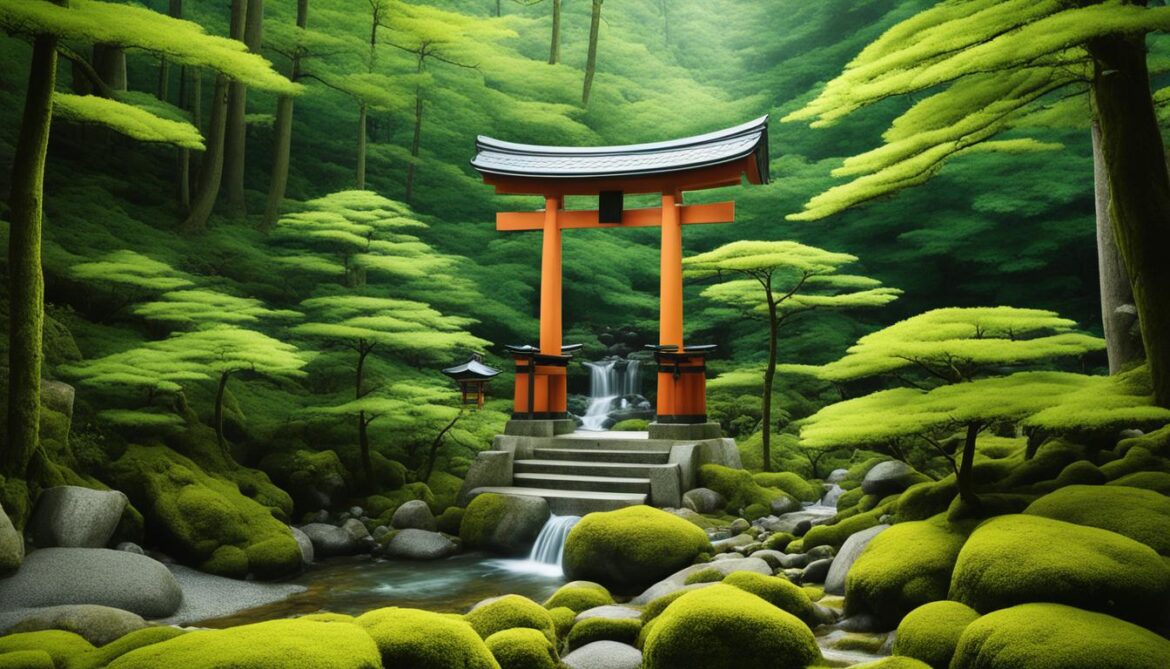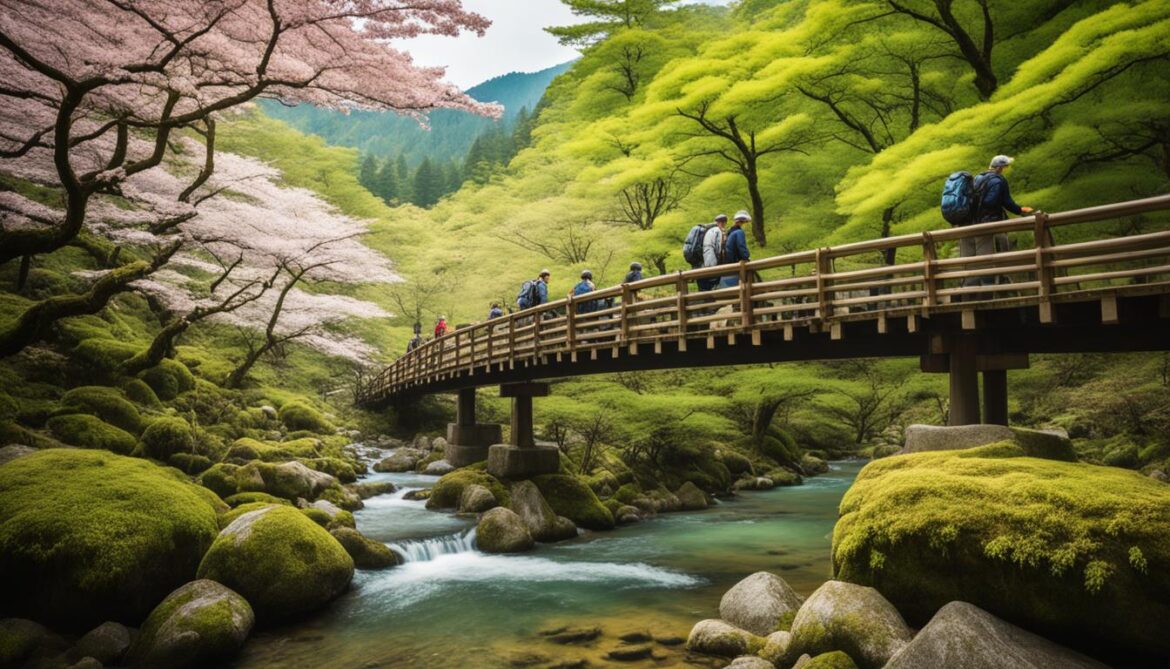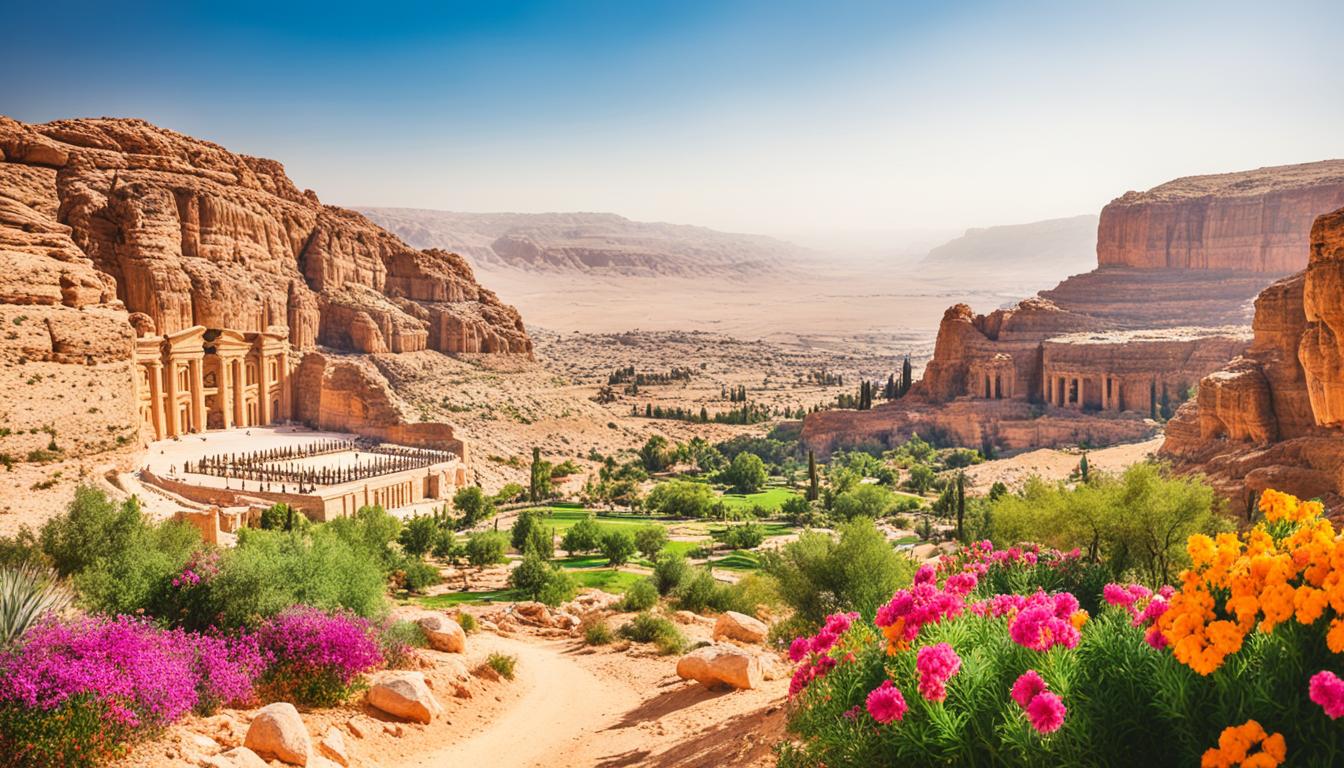Japan Sacred Natural Sites and Biodiversity
Did you know that sacred natural sites (SNS) are recognized as the oldest form of habitat protection in human history? These sites, found all over the world, play a vital role in preserving biodiversity and cultural traditions. And when it comes to the intersection of sacred natural sites and biodiversity, Japan is a hidden treasure waiting to be discovered.
Key Takeaways:
- Japan’s sacred natural sites contribute to the conservation of its rich biodiversity and cultural heritage.
- Efforts are needed to fill geographical and taxonomical gaps in our understanding of sacred natural sites.
- Sacred natural sites serve as important areas for both biodiversity conservation and the preservation of cultural traditions.
- Japan’s commitment to biodiversity conservation is evident in its support for research, conservation projects, and sustainable development.
- Ecotourism in sacred natural sites offers unique opportunities for cultural exchange and contributes to local economies.
The Importance of Sacred Natural Sites
Sacred natural sites play a crucial role in both nature conservation and the preservation of cultural traditions. These sites, considered sacred by indigenous and traditional peoples, are often associated with religious or spiritual practices. They not only protect a wide variety of habitats and species but also contribute to the conservation of cultural practices and knowledge related to biodiversity. Sacred natural sites promote a mutual respect between people and nature, fostering sustainable relationships that have existed for centuries.
“Sacred natural sites are not just places of worship; they are the world’s oldest conservation areas, where the protection of nature is deeply intertwined with spirituality and cultural heritage,” says Dr. Maria Santos, a leading expert in biodiversity conservation.
These unique sites can be found in every country, serving as hotspots of biocultural diversity. They provide a home for rare and endemic species, making them crucial for biodiversity conservation efforts. Moreover, sacred natural sites offer valuable opportunities for learning about different cultural traditions and promoting cultural diversity.
The Significance of Sacred Natural Sites
Sacred natural sites hold immense value in various aspects:
- Nature conservation: These sites protect important ecosystems and natural resources, preserving the integrity of landscapes and habitats.
- Cultural diversity: Sacred natural sites contribute to the conservation of cultural practices, traditional knowledge, and cultural diversity.
- Sustainable relationships: They promote a symbiotic relationship between indigenous and traditional communities and nature, fostering sustainable practices and mutual respect.
By recognizing and supporting the conservation of sacred natural sites, we can ensure the preservation of both biological and cultural heritage for future generations.
Illustration: An example of nature conservation at sacred natural sites.
| Biodiversity Conservation | Cultural Diversity |
|---|---|
| Protects a wide variety of habitats and species | Preserves cultural practices and knowledge related to biodiversity |
| Helps prevent species extinction | Promotes cultural exchange and understanding |
| Contributes to maintaining ecosystem balance | Fosters sustainable relationships between people and nature |
Table: The interconnection between biodiversity conservation and cultural diversity at sacred natural sites.
The Role of Sacred Natural Sites in Conservation
While Protected Areas (PA) are the cornerstone of nature conservation, there is growing interest in complementary conservation measures, such as Sacred Natural Sites (SNS), which are often independent of PAs. SNS are considered informal PAs and may constitute a large network of protected areas. Research has shown that SNS have the same, or even higher, levels of species richness compared to official reserves. They also serve as refugia for endemic, threatened, rare, or specialist species and preserve old-growth trees and forest patches. In some cases, SNS are the only patches of natural or semi-natural habitat in highly modified landscapes.
SNS play a significant role in biodiversity conservation by providing additional protection for species and habitats beyond traditional PAs. The presence of SNS contributes to the overall species richness and provides refuge for species that are endemic, threatened, or have specialized ecological requirements. These sites also support the preservation of old-growth trees, which are important for maintaining healthy ecosystems and providing habitat for a variety of species.
The conservation value of SNS extends beyond their ecological benefits. These sites are often of great cultural and spiritual significance to local communities and indigenous peoples. They are considered sacred and are associated with traditional practices and knowledge. By conserving SNS, we also preserve indigenous cultures and their connection to the natural world, promoting the sustainable management of both cultural and biological diversity.
“Sacred Natural Sites have the same, or even higher, levels of species richness compared to official reserves.”
The informal nature of SNS allows for flexibility in their governance and management. They are not bound by strict regulations and can adapt to the needs and values of local communities. This informality also enables the conservation of unique and valuable habitats that may not meet the criteria for formal protected status. By recognizing the role of SNS and integrating them into conservation frameworks, we can enhance the resilience and effectiveness of conservation efforts.
Conservation Benefits of Sacred Natural Sites:
- Protection of species richness
- Refugia for endemic, threatened, rare, or specialist species
- Preservation of old-growth trees and forest patches

SNS have demonstrated their conservation value globally, serving as important components of the overall protected area network. The role of SNS is increasingly recognized as an effective conservation strategy, complementing traditional PAs and contributing to the preservation of global biodiversity.
| Conservation Benefits | Informal PAs |
|———————————-|———————————-|
| Species richness | Same or higher levels compared to official reserves |
| Endemic, threatened, and rare species | Refugia for these species |
| Old-growth trees and forest patches | Preserve these habitats |
In summary, the inclusion of Sacred Natural Sites in conservation efforts provides multiple benefits for biodiversity and cultural heritage. These sites maintain high levels of species richness, protect endemic and threatened species, and preserve important habitats such as old-growth trees. By recognizing the value of SNS and incorporating them into conservation frameworks, we can ensure the preservation of these unique and significant areas for future generations.
The Need for Recognition and Conservation
Despite their significance, the global network of sacred natural sites is under-funded and faced with increasing threats. These sites are often threatened by ignorance, overconsumption, and overexploitation of resources, risking the destruction of these invaluable sites. The destruction of sacred sites has far-reaching implications, not only for the loss of biodiversity but also for the disruption of meaningful and sustainable relationships between humans and nature.
Recognition of the positive effects of sacred natural sites on biodiversity is crucial. It is essential to incorporate these sites into appropriate conservation frameworks to ensure their long-term preservation. Specific forms of governance and management, which are intrinsic to the functioning of sacred natural sites, need to be acknowledged and supported to enable effective conservation efforts.
Under-funded and increasingly threatened, sacred natural sites face the risk of destruction. It is vital to recognize their positive impact on biodiversity and integrate them into conservation frameworks. Support for the specific governance and management of these sites will ensure their preservation for future generations.
The Destruction of Sacred Sites
The destruction of sacred sites not only results in the loss of important cultural and spiritual heritage but also has severe consequences for biodiversity conservation. These sites often harbor unique ecosystems and rare species that are threatened by human activities. Unsustainable practices, such as illegal logging, mining, and urban encroachment, pose significant challenges to the preservation of sacred natural sites.
“The destruction of sacred sites not only erodes our cultural heritage but also poses a threat to the delicate balance of biodiversity. Urgent action is required to prevent further destruction and establish effective conservation measures.” – Dr. Sarah Thompson, Conservation Biologist
Incorporating Sacred Sites into Conservation Frameworks
To ensure the long-term survival of sacred natural sites, it is essential to give them the recognition they deserve within conservation frameworks. By formally acknowledging and protecting these sites, we can safeguard their unique biodiversity and cultural value. This includes allocating adequate financial resources to support conservation initiatives and promoting sustainable practices that respect the sacredness of these sites.
Governance and Management of Sacred Natural Sites
The governance and management of sacred natural sites require specific considerations due to their cultural and spiritual significance. Traditional custodians, local communities, and indigenous peoples play a crucial role in the stewardship of these sites, drawing upon their traditional knowledge and practices. Empowering these communities and involving them in decision-making processes will ensure the effective conservation and sustainable management of sacred natural sites.
| Issue | Challenge | Solution |
|---|---|---|
| Under-funding | Insufficient financial resources impede effective conservation efforts. | Allocate adequate funding for the preservation of sacred natural sites. |
| Threats to Sites | Illegal activities, urban encroachment, and unsustainable practices pose severe threats to sacred sites. | Implement strict regulations and enforcement mechanisms to protect sacred sites from destructive activities. |
| Destruction of Cultural Heritage | The destruction of sacred sites erodes cultural and spiritual practices and knowledge. | Promote awareness and education to foster respect and understanding of the cultural significance of sacred sites. |
| Maintenance of Biodiversity | The destruction of sacred sites jeopardizes unique ecosystems and rare species. | Integrate sacred sites into conservation frameworks to ensure the preservation of biodiversity. |

The destruction of sacred sites highlights the urgent need for their recognition and conservation. By addressing under-funding, implementing effective conservation measures, and involving local communities, we can protect these invaluable sites and safeguard both biodiversity and cultural heritage.
Sacred Natural Sites in Japan
Japan is renowned for its abundant sacred natural sites, which play a vital role in the conservation of the country’s diverse biodiversity. These sacred sites encompass a wide range of areas, including ancient groves, majestic mountains, picturesque islands, and serene temples nestled within natural or semi-natural surroundings. These sites not only provide breathtaking landscapes and cultural heritage but also serve as valuable biodiversity hotspots, teeming with unique and endemic species.
One particularly enchanting example of a sacred natural site in Japan is the sacred grove located in the heart of Mount Koya. Surrounded by lush greenery, this tranquil grove exudes a sense of spirituality, attracting visitors seeking solace and a deeper connection with nature. It is home to a myriad of plant and animal species, adding to its significance as a biodiversity hotspot.
Eco-tourism in these sacred natural sites offers visitors an incredible opportunity to immerse themselves in the beauty of Japan’s natural wonders while contributing to the preservation of the country’s rich biodiversity. By engaging in sustainable tourism practices, such as guided nature walks, wildlife spotting, and educational programs, visitors can not only enjoy a memorable experience but also support local economies and promote environmental awareness.
“The sacred natural sites in Japan provide a unique blend of cultural heritage and natural beauty, making them truly exceptional destinations for eco-tourism,” says Hiroshi Tanaka, a renowned environmentalist and founder of the Japan Sacred Natural Sites Conservation Society. “Visitors have the chance to witness the harmonious coexistence of spirituality and nature while actively participating in conservation efforts.”
Preserving these sacred natural sites is of utmost importance for the conservation of Japan’s natural heritage and the promotion of sustainable relationships between people and nature. Efforts are underway to enhance the recognition and protection of these sites through stringent conservation measures, collaborations with local communities, and integration into national and international conservation frameworks.
| Sacred Natural Site | Location | Biodiversity Highlights |
|---|---|---|
| Mount Koya | Wakayama Prefecture | Endemic species, diverse plant communities, and rich avian fauna |
| Miyajima Island | Hiroshima Prefecture | Unique marine ecosystems, sacred deer population, and rare plant species |
| Kumano Kodo | Wakayama, Mie, and Nara Prefectures | Old-growth forests, pristine rivers, and cultural heritage |

Recognizing the cultural and ecological significance of these sites, initiatives have been implemented to involve indigenous and local communities in their governance and management. Their traditional knowledge and practices contribute to sustainable management strategies and ensure that these sites continue to thrive for future generations.
The preservation of sacred natural sites in Japan not only safeguards the country’s invaluable natural heritage but also fosters a deeper understanding and appreciation of the intricate relationship between humans and the environment. By visiting and supporting these sites, individuals can make a positive impact on biodiversity conservation while experiencing the awe-inspiring beauty of Japan’s sacred landscapes.
Conservation Efforts in Japan
Japan is dedicated to preserving its rich biodiversity through various conservation initiatives. These efforts encompass the safeguarding of sacred natural sites, active collaboration between government agencies, non-governmental organizations (NGOs), and local communities. The aim is to protect not only the ecological value of these sites but also their cultural significance.
Conservation in Japan is grounded in the recognition of the vital role that indigenous and local communities play in the governance and management of sacred natural sites. Their deep-rooted connection to the land and their traditional knowledge and practices are essential in ensuring the long-term conservation of biodiversity. By integrating cultural practices with conservation efforts, Japan seeks to promote a harmonious relationship between humans and nature.

These conservation initiatives extend beyond the preservation of sacred natural sites to encompass broader nature conservation in Japan. The country actively engages in sustainable management practices, which involve implementing appropriate governance frameworks and fostering cooperation among stakeholders. This collaborative approach reinforces the commitment to biodiversity conservation and ensures the preservation of Japan’s unique natural heritage.
The Role of Indigenous and Local Communities
“Indigenous and local communities are the custodians of ancestral knowledge and practices that are invaluable for the conservation of biodiversity and the sustainable management of sacred natural sites.” – Hiroshi Tanaka, Conservationist
Indigenous and local communities possess valuable knowledge about the local ecosystems and have developed sustainable practices over generations. Their participation in conservation efforts allows for the integration of traditional practices and contemporary conservation strategies, creating a holistic approach to nature conservation.
Collaboration Between Government Agencies and NGOs
Conserving biodiversity in Japan is a collaborative effort between government agencies and NGOs. This partnership enables the creation and implementation of effective conservation policies, the allocation of necessary resources, and the promotion of research and education initiatives. By working together, these organizations enhance the conservation efforts and contribute to the long-term success of biodiversity preservation in Japan.
Future Directions
Looking ahead, Japan will continue to strengthen its conservation efforts by addressing existing challenges and advancing knowledge in the field. Research will focus on filling geographical and taxonomical gaps to gain a comprehensive understanding of Japan’s biodiversity. Sustainable management practices will be refined and implemented, ensuring the continued conservation of sacred natural sites and the preservation of Japan’s natural heritage for future generations.
| Conservation Efforts in Japan | Key Highlights |
|---|---|
| Collaboration | Government agencies, NGOs, and local communities work together. |
| Indigenous and Local Communities | Play a vital role in governance and management, leveraging traditional knowledge. |
| Sustainable Practices | Integration of cultural practices with conservation efforts. |
| Future Directions | Addressing challenges, advancing knowledge, and refining sustainable management practices. |
Japan’s Commitment to Biodiversity Conservation
Japan has exemplified a steadfast dedication to biodiversity conservation through the implementation of robust conservation policies and initiatives. This commitment has garnered international recognition, highlighting Japan’s efforts in preserving its diverse range of flora and fauna while fostering sustainable development.
The Japanese government has demonstrated its unfaltering support for research and conservation projects aimed at safeguarding the nation’s unique biodiversity. Across various sectors, there is a concerted effort to integrate biodiversity considerations into policymaking and planning processes. Such holistic approaches ensure that Japan’s natural wealth is preserved for future generations.
One noteworthy aspect of Japan’s commitment to conservation is its recognition of the importance of protecting sacred natural sites. The government’s dedication to preserving these sites is a testament to its profound respect for the country’s ecological and cultural heritage. By safeguarding sacred natural sites, Japan not only safeguards biodiversity but also preserves the spiritual and cultural significance associated with these areas.
“Japan’s commitment to biodiversity conservation is essential for maintaining ecological balance and nurturing a harmonious relationship between society and nature.” – Dr. Hiroshi Tanashi, Biodiversity Conservation Expert
Japan’s active role in biodiversity conservation stems from a deep understanding of the need to protect and sustainably manage natural resources. The government recognizes that a balanced approach to development is crucial for the well-being of both current and future generations. Through conservation policies and initiatives, Japan strives to strike a harmonious equilibrium between economic growth and the protection of its natural heritage.
As Japan continues to lead by example, its dedication to biodiversity conservation serves as an inspiration to other countries. By prioritizing the preservation of its rich natural environment, Japan showcases the potential for sustainable development and the inherent value of biodiversity.
| Conservation Policies | International Recognition |
|---|---|
| 1. Implementation of strict regulations to protect endangered species | 1. Japan’s commitment acknowledged by the Convention on Biological Diversity |
| 2. Promotion of sustainable land and resource management practices | 2. Recognition as a biodiversity hotspot by international organizations |
| 3. Support for research and conservation projects | 3. Inclusion in the UNESCO World Heritage List for significant natural sites |
Through its determined efforts in biodiversity conservation, Japan sets a precedent for sustainable development worldwide. By valuing its natural resources, Japan paves the way for a future where humanity lives in harmony with nature, fostering a resilient and vibrant planet for generations to come.

Challenges and Future Directions
While progress has been made in understanding the importance of sacred natural sites, there are still challenges and gaps that need to be addressed. Geographical and taxonomical biases in research limit our understanding of the full extent of the benefits of sacred natural sites (SNS). To advance knowledge and conservation efforts, it is crucial to fill these conservation gaps and overcome biases through more comprehensive and systematic research on SNS.
Filling Conservation Gaps
Research on sacred natural sites has predominantly focused on Asia and Africa, with limited representation from other regions. This geographical bias hinders our understanding of the role that SNS play in biodiversity conservation worldwide. To gain a more holistic perspective, future research efforts should aim to study and document the significance of SNS from diverse geographical locations, including Europe, the Americas, and Oceania.
Conservation gaps, Research on sacred natural sites
Addressing Geographical and Taxonomical Biases
In addition to geographical biases, research on SNS has predominantly focused on plants, neglecting other taxa such as animals, fungi, and microorganisms. To fully comprehend the ecological and conservation value of SNS, future studies should adopt a comprehensive approach that encompasses the entire spectrum of biodiversity. This will provide a more accurate understanding of the role SNS play in sustaining overall ecosystem health and functioning.
Geographical and taxonomical biases, Advancing knowledge
Ensuring Sustainable Management
The sustainable management of sacred natural sites is critical for their long-term conservation. Best practices and guidelines need to be developed and implemented to ensure that SNS are effectively protected and managed. Integrating traditional ecological knowledge and engaging local communities in the governance and conservation of these sites can contribute to their sustainable management.
Sustainable management
“Conservation efforts should aim to address the underfunding and increasing threats faced by sacred natural sites. The destruction of these sites not only impacts biodiversity but also risks severing the cultural and spiritual connections that have been nurtured for centuries. Through the recognition of their positive effects on biodiversity and effective governance models, we can ensure the preservation and sustainable management of sacred natural sites for future generations.” – Dr. Sakura Tanaka
By bridging conservation gaps, addressing geographical and taxonomical biases, and implementing sustainable management practices, we can enhance our understanding of sacred natural sites and their vital role in biodiversity conservation. This knowledge will facilitate the development of effective conservation strategies that safeguard these unique and culturally significant spaces for generations to come.
Ecotourism and Sacred Natural Sites in Japan
The unique blend of nature and spirituality in sacred natural sites makes them attractive destinations for eco-tourism in Japan. These sites offer a rare opportunity for visitors to connect with the natural world while immersing themselves in the cultural and spiritual significance of these sacred places.
Sustainable tourism practices are key to ensuring the long-term preservation of these sites and the surrounding ecosystems. By promoting sustainable tourism in sacred natural sites, Japan can create economic opportunities for local economies while also raising awareness about the importance of biodiversity conservation.
Visitors to these sites can engage in cultural exchange as they learn about traditional practices and beliefs. This exchange of ideas and experiences fosters a deeper appreciation for the connection between humans and nature.
Ecotourism activities in sacred natural sites provide a unique platform for individuals to actively contribute to the conservation efforts of these sites. By supporting local communities and participating in conservation initiatives, visitors can play an active role in sustainable management and the preservation of sacred natural sites in Japan.

Ecotourism in sacred natural sites not only benefits the environment and local economies, but it also enriches the experience of visitors, offering them a deeper understanding and appreciation of Japan’s rich cultural and natural heritage.
| Benefits of Ecotourism in Sacred Natural Sites | Examples |
|---|---|
| Preservation of biodiversity | Visitors contribute to conservation efforts through entry fees and participation in ecological projects. |
| Support for local economies | Local communities benefit from tourism-related activities, such as guiding, accommodations, and the sale of local products. |
| Cultural exchange | Visitors have the opportunity to interact with locals, learn about traditional practices, and gain insights into the cultural significance of these sites. |
| Raise awareness for biodiversity conservation | By experiencing the beauty and importance of sacred natural sites, visitors develop a greater appreciation for biodiversity and become advocates for its conservation. |
Conclusion
Sacred natural sites in Japan play a significant role in biodiversity conservation and the preservation of cultural heritage. These sites contribute to the positive effects on taxonomical diversity, vegetation structure, and cultural uses of biodiversity. To ensure the long-term conservation of sacred natural sites, it is crucial to recognize their importance in appropriate conservation frameworks and provide support for their governance and management. Japan’s commitment to biodiversity conservation and sustainable development is evident in its efforts to preserve these sites and promote eco-tourism as a means to engage visitors in conservation activities.
Continued research and collaboration are key to addressing gaps in knowledge and advancing the sustainable management of sacred natural sites not only in Japan but also globally. By working together, we can enhance our understanding of the value of these sites and their role in protecting Japan’s biodiversity and natural heritage. This knowledge can guide future conservation initiatives and ensure the preservation of these invaluable ecosystems for generations to come.
As we appreciate the unique blend of nature and spirituality found in sacred natural sites, we also recognize the importance of sustainable tourism and its potential in supporting local economies and promoting cultural exchange. Through responsible and mindful exploration, visitors can contribute to the conservation efforts of these sites while gaining a deeper appreciation for Japan’s rich biodiversity and cultural traditions.
In conclusion, the conservation of Japan’s sacred natural sites is crucial for the preservation of its biodiversity and cultural heritage. By recognizing their significance, implementing effective conservation frameworks, and fostering sustainable management practices, we can ensure the long-term viability of these sites and their contribution to the protection and celebration of Japan’s natural and cultural treasures.








